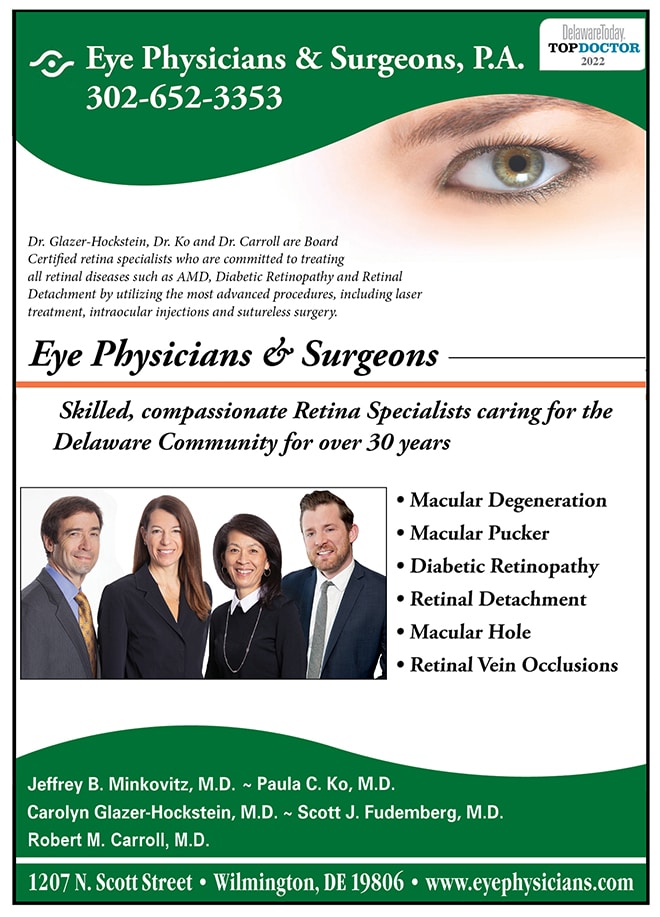Pucker Up! What You Should Know About Epiretinal Membranes
By Robert M. Carroll, M.D.
As a retina specialist, I see a variety of different problems affecting this important tissue layer that lines the back of the eye on a daily basis. One of the more common diseases for which patients are referred to me is an epiretinal membrane (ERM) or “macular pucker.” An ERM is a thin, semi-translucent layer of scar tissue that grows abnormally on the surface of the retina. If it starts to grow over the central part of the retina (known as the macula), it can pull and contract (pucker) the retina tissue leading to visual symptoms.
In the vast majority of patients, an ERM is purely idiopathic and somewhat related to normal aging changes of the eye. About 2% of patients over age 50 have evidence of an ERM; this number increases to about 20% of patients over age 75. In some patients, it can develop in response to prior trauma, infection, retinal tear or detachment, or other inflammatory event affecting the inside of the eye. While there is typically nothing to do to prevent ERM development, the good news is that the vast majority of patients with this condition have minimal to no symptoms and can simply be observed.
For some patients, though, as the ERM pulls on the retina it can start to cause blurry vision (often times vague and gradual in onset) and distorted vision (straight lines look crooked or wavy). Less commonly, an ERM can lead to images looking larger or smaller than their actual size and can even cause double vision. These symptoms can be incredibly frustrating for patients as they can be difficult to measure and require a careful examination to identify the problem.
An ERM is diagnosed with a combination of a dilated eye exam and specialized retinal imaging called optical coherence tomography (OCT). During the dilated eye exam, a retina specialist is able to detect the presence of the ERM growing on the surface of the tissue. The OCT machine uses light to create a cross-section image of your retina, allowing for further identification of an ERM. This technology is extremely helpful in monitoring patients with this condition as it serves as a measure for the level of distortion caused by the ERM as well as any progression over time.
As mentioned, most patients with an ERM can be monitored throughout their life without need for any intervention. For patients experiencing symptoms, though, a retina specialist may recommend surgery for this condition. This procedure, known as a vitrectomy, is performed in an operating room and entails small incisions into the white part of the eye to remove the gel-like substance within. This allows for access to the retina, where the ERM is delicately removed from the surface with microscopic forceps. By removing this membrane, the retina tissue can then relax back to a more normal configuration, with gradual improvement in symptoms. This improvement can take time and can sometimes be incomplete, but most patients who require ERM surgery should experience some level of benefit. This surgical procedure is generally low-risk and well tolerated, but the decision for surgery and its risks and benefits should always be thoroughly discussed with a retina specialist.
If you are experiencing the symptoms reviewed in this article or have been diagnosed by an eye care professional with an epiretinal membrane/macular pucker and would like to schedule an appointment with a retina specialist at Eye Physicians and Surgeons, please call 302-652-3353 or visit www.eyephysicians.com.
Bio
Dr. Robert Carroll. Dr. Carroll isRobert M. Carroll, M.D. is a board-certified, fellowship-trained retina specialist. Dr. Carroll focuses on the evaluation and treatment of patients with medical retinal disease such as diabetic retinopathy, age-related macular degeneration, retinal vascular disease, and posterior uveitis. He also performs retinal surgery to treat retinal detachment, macular holes and puckers, complications from diabetes, and secondary intraocular lenses.
Originally from New Jersey, Dr. Carroll completed his undergraduate degree in biochemistry with honors at the University of Notre Dame and earned his medical degree at Rutgers-Robert Wood Johnson Medical School. He completed his internship at Albert Einstein Medical Center in Philadelphia, residency in ophthalmology at Mount Sinai Hospital in New York City, and fellowship in vitreoretinal surgery at the Scheie Eye Institute of the University of Pennsylvania, where he was awarded the Fellow Excellence in Teaching Award. He previously worked in private practice in Philadelphia and currently cares for our nation’s veterans at the Wilmington, Delaware VA Medical Center.
An Eagle Scout, Dr. Carroll prides himself on humbly serving his patients by putting their needs first in the preservation and restoration of their vision. He is a member of the American Academy of Ophthalmology and the American Society of Retina Specialists and has maintained an active academic interest, publishing in and serving as a reviewer for several ophthalmology journals as well as teaching optometry and ophthalmology students, residents, and fellows. Dr. Carroll will be seeing patients at Eye Physicians and Surgeons, 1207 North Scott Street, Wilmington, Delaware. He is trained in the most up to date methods of diagnosing and treating retinal disease, including intravitreal injections, retinal lasers, sutureless retinal surgery, and advanced retinal imaging.
Eye Physicians & Surgeons, P.A. 1207 North Scott Street, Wilmington, Delaware 302-652-3353 eyephysicians.com
follow us on facebook & instagram



